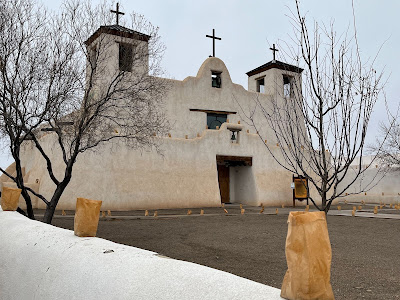Growing up in Santa Fe, New Mexico, I visited a lot of missions, old churches, and pueblos through the years. Sometimes with my family; sometimes on school field trips. Sadly, like most kids, I didn't appreciate the things I saw and heard on those long ago visits. Now that I'm old and wise (ha!) I soak up the history of the places I visit. Such is the case of my Christmas pilgrimage to Isleta Mission, 15 miles south of Albuquerque, New Mexico.
 |
| Isleta Mission Church. Photos by Michelle Shocklee |
Pilgrimage, you ask?
Yep. Let me tell you a little story before I get into the history of the mission.
My dad's parents were born in Mexico in the 1880s. They were both teenagers when their families immigrated to Texas where they met, married, and started a family. My grandfather attended the Baptist seminary in El Paso and became a Baptist minister. Because vital records in Mexico are hard to locate, I didn't hold out much hope of ever knowing much about my ancestors on Dad's side of the family beyond a few names of my great grandparents. Thankfully I was wrong! When a friend gifted me with an Ancestry .com DNA kit last year, I was wonderfully surprised to discover all sorts of people I was related to through my dad's family, dating all the way back to my 7th great grandmother!
That's where the history of Isleta Mission and my family history converge.
But all was not well. North of Isleta, unrest between the Spanish colonists and the Pueblo tribes continued to escalate. For more than 100 years, the Pueblo people were subjected to the unwelcome presence of soldiers, missionaries, and settlers. These encounters between people of different backgrounds and religious beliefs were characterized by violent confrontations between Spanish colonists and Pueblo peoples, including the horrific massacre of over 800 Acoma Pueblo men, women, and children.
The people of Isleta Pueblo did not participate in the revolt. Instead, they offered shelter to the Spanish refugees... including my ancestors! While we don't have all the details of what happened to them, I know that my 7th great grandmother was born in Santa Fe in 1664. Her son was born at the Isleta Pueblo in 1683. If we piece together historical facts, we can guess that my family escaped from Santa Fe sometime during the revolt and fled to Isleta. They would have continued their flight to El Paso but later returned when the Spanish once again occupied the mission.
I have no way of knowing if my ancestors participated in the violence against Native Americans. I certainly hope not. But history can't be changed. We can only learn from it and hopefully make the world a better place, where everyone can live in peace.
 |
| Me at Isleta Mission with my DNA results |
Your turn! Have you looked into your ancestry? Are there any surprises you'd like to share with us?
Michelle Shocklee is the author of several historical novels, including Under the Tulip Tree, a Christy Awards and Selah Awards finalist. Her work has been included in numerous Chicken Soup for the Soul books, magazines, and blogs. Married to her college sweetheart and the mother of two grown sons, she makes her home in Tennessee, not far from the historical sites she writes about. Visit her online at www.MichelleShocklee.com
COUNT THE NIGHTS BY STARS
*2023 Christianity Today Book Award Winner*
1961. After a longtime resident at Nashville’s historic Maxwell House Hotel suffers a debilitating stroke, Audrey Whitfield is tasked with cleaning out the reclusive woman’s room. There, she discovers an elaborate scrapbook filled with memorabilia from the Tennessee Centennial Exposition. Love notes on the backs of unmailed postcards inside capture Audrey’s imagination with hints of a forbidden romance . . . and troubling revelations about the disappearance of young women at the exposition. Audrey enlists the help of a handsome hotel guest as she tracks down clues and information about the mysterious “Peaches” and her regrets over one fateful day, nearly sixty-five years earlier.
https://www.tyndale.com/p/count-the-nights-by-stars/9781496459930
https://www.tyndale.com/p/count-the-nights-by-stars/9781496459930






Thank you for posting today and Happy New Year! I'm happy that you have traced your family's history back so far. I have a cousin who lives for this kind of thing and she has blessed our family with her discoveries. She could probably highlight many things, but I don't have a good memory for those details.
ReplyDeleteHappy new year to you too, Connie! Yes, it's been fun tracing my roots! =)
DeleteI've traced several family lines of mine back through my DNA submission to Ancestry.com and also, at my local library I found a book that traces a family line on my dad's side back to England in the 1600. In a recent update on my DNA, I've learned I have more Scottish blood in me than English. I've had a few surprises in my research.
ReplyDeleteIt wasn't through my DNA, but early in my family history research I came across reference to an aunt of my dad's named Mary. When I asked him about her, he said he wasn't aware of such a person. By going to the courthouse in the Ohio town where the family is from,I located a reference to a Mary who was an older sister of my dad's mother. Long story short, after more digging I found out my paternal g-mother had an older sister who died before my dad was born. It was far enough before that conversation about her had gone over his head, and being he never knew her, it was a surprise to him. It was fun to go to his room at the nursing home where he was and tell him I found Aunt Mary. Ancestry.com used to publish a magazine and they published an article about my experience in their magazine.
DeleteThat's cool, Pamela! My cousin finds out things like this all the time, I just can't remember her stories!
Delete